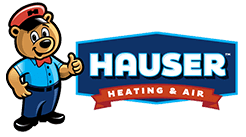1. If your A/C is not cooling enough, the easiest and most important thing you can do on your own is: check /change your filter. If this does not remedy the problem, Call for service. Note: there is a possibility that your A/C system may be doing all it can do during extreme heat conditions.
2. Air Conditioners must have a filter. The filter will be located inside your home either with the equipment or behind a grille inside your home perhaps a hallway. It is very important that the filter is changed or cleaned regularly in order to filter the air properly and prevent the indoor coil from getting dirty. 1″ filters=change every month; 2″ filters=change every 2 months; 4-5″ filters=change every 6-12 months. Filters will get dirtier faster if: there are multiple pets, there is a dusty outdoor environment such as dirt roads, fields, construction, etc; if carpets are infrequently vacuumed. We sell all types of filters and offer special savings on buying three. You can call the office to order yours at: (513) 777-7979. We recommend to keep them on hand to change.
3. Be sure to keep the outdoor condenser clean. This means ALL sides should have nothing clinging to them (the sides look like radiator fins or sometimes they are “spiny” looking). If you do see dirt, leaves, grass clippings, cottonwood, you can use a water hose with spray nozzle to rinse the sides off starting at the top and working your way down. Turn off the power first. We recommend having a tune up & cleaning on your A/C once a year.
4. During the summer, if you see frost on the outdoor or indoor pipes, your system is frozen and will not cool properly. The system must be thawed in order to solve this issue. The quickest way to thaw the system is to turn the ac off at the thermostat but turn the FAN to ON. This will force warm air over the ice to thaw it quicker. It may still take 2 hours to thaw. NOTE: once the air conditioner is thawed, when you turn it on, it may start cooling again and continue to cool until it freezes up again- maybe a day or two. This freezing up and thawing will continue until the root problem is resolved. It is not good for this to continue for days. The root problem could be a dirty filter. If changing your filter does not remedy the situation, Call for service.
5. Do not set your thermostat below 70 degrees as it will not cool any faster and could freeze up the system causing more problems.
6. Understand that there is generally a 20 degree difference between indoor air and outside temperatures. So when it is 92 degrees outside, you can expect to get your indoor temperature to 72 degrees if desired. However, if it is 102 degrees outside, your air conditioner may struggle to meet 72 or run all the time trying to meet the demand.
7. If you see water leaking from an outdoor pipe or pipe located above a bathtub, this means that your primary condensate drain has a problem and the water is traveling through the emergency drain system. This pipe is usually located in a conspicuous area so that you will easily see the water dripping and know that there is a problem. Call for service.
8. Plant NEW bushes or plants at least 24-36 inches from the outdoor unit. If you have mature bushes near the outdoor unit, keep them trimmed to 12-18″ away. The outdoor unit needs to “breathe” freely without any hindrance. If you already have bushes planted around the a/c, be sure to keep them trimmed to allow the recommended clearance.
9. Do not place anything above your outdoor unit such as a shade, awning, fence, etc. Air blows out the top of the air conditioner and it must be able to blow out freely without any hindrance whatsoever.
10. If you have a basic programmable thermostat, do not “off-set” it more than 5 degrees while away (during extreme weather temperatures). Otherwise it will work too hard to bring the temperature to the desired point thus defeating the energy saved.
11. Keep curtains and blinds closed on west side of house during the summer.
12. Air conditioning systems do not require “freon” every year. They may need it if there is a leak, but the “freon” is not consumed. Some leaks are very very small and difficult to detect while some are larger and easier to detect and locate.
13. If you have a refrigerant leak, the leak may be located at the indoor equipment, the outdoor equipment or in the copper lines that connect the two pieces of equipment. Some leaks are repairable while some are not.
14. Be careful using a weed eater around the outdoor unit. If the wires or piping are cut, call for service.


